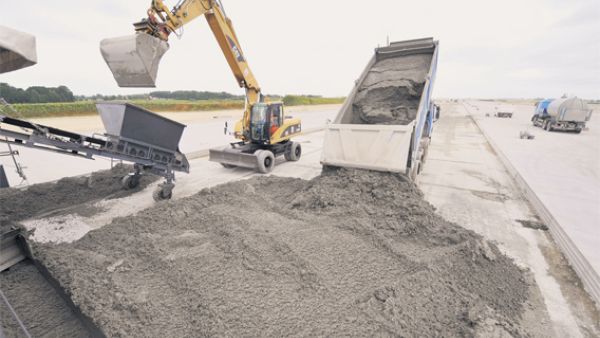With massive investments being pumped into the infrastructure space, the outlook for the Saudi cement sector looks bright in the coming years.
Cement companies have benefited largely from cheap raw materials and fuel availability, making them outstandingly profitable. However, there are some concerns on fuel supply, which acts as a major hurdle for the sector.
A report by Al-Watan newspaper said last year citing Ali Al-Ayed, the Saudi Industrial Development Fund’s director general, that Saudi Arabian Cement Co.(ARCCO) production capacity exceeds demand in local markets. He said the demand may reach 55 million tons this year, while the capacity of 18 percent cement production is at 59 million tons, the newspaper said.
Another report published recently disclosed that the cement crisis is re-emerging in the Eastern Region as a number of distributors are increasing their prices to consumers by up to 25 percent with a normal bag sold at SR 20 and a solid one at SR 21.
The Ministry of Commerce and Industry has issued regulations specifying the price of cement at SR12 for the ordinary and SR 13 for the solid category. The ministry is obligating factories in the country to work at full capacity to cover the market and ensure additional supplies for the areas that need cement.
According to the Vice President of the Contractors Committee in the Eastern Chamber, Khaliefa Al-Dabeeb, one of the reasons for the cement crisis is the growing demand from the mega projects in Saudi Arabia. He added that the problem is further aggravated by the greedy intermediaries and also the willingness of factories to sell cement to any company, local or foreign, resulting in the price fluctuation.
Further, the Kingdom has embarked on multibillion dollar infrastructure and housing construction plans, putting pressure on resources such as cement. The country faces a massive housing problem due to rapid population growth and an inflow of expatriate workers enticed by jobs in the oil and construction sectors.
With the massive demand for cement in the mega government projects on one hand and government directives to meet the deadline on the other, Custodian of the Two Holy Mosques King Abdullah has ordered the import of 10 million tons of cement this year to end any shortage in the country.
The Saudi leadership wants three to four cement plants to be built over the next three years and has granted SR 3 billion toward the scheme, according to Minister of Commerce and Industry Tawfiq Al-Rabiah.
The minister earlier this month had asked cement producers to build a strategic reserve of two months’ inventory at each plant and to cover any shortage by importing cement. This is due to the fact that the demand for cement is expected to increase by 9.4 percent a year to over 80 million tons (73 million tons) by 2017, according to a new report released by market research firm, CWC Group.
Arabian Cement has been identified as the top pick in the cement sector owing to its robust revenue and earnings growth, proximity to the Western Region (which is undergoing massive expansion) as well as an open investor relations. Arabian Cement has maintained high utilization rates on the back of the massive construction and cement demand in the Western Region.
However, the company seems to be struggling with its Jordan subsidiary. "We have therefore cut our estimates on its Jordan subsidiary but still remain positive on its investment in Jordan as it is one of the higher margin markets. Arabian cement appears undervalued with a modest 2013 PE of 7.8 percent, and a dividend yield of 6 percent makes us believe that the company has a healthy upside potential," says the CWC report.
Arab News tried to get comments from some top Saudi executives active in the field of cement but they declined to offer any as they are "not allowed to disclose any information." A report of Al-Rajhi Capital, Saudi Outlook 2013, on Saudi Cement sector revealed a positive outlook, although concerns persist. The report said, with massive investments ongoing in the infrastructure space, the outlook for the Saudi cement sector looks positive in the coming years. Cement companies have benefited largely from cheap raw materials and fuel availability, making them outstandingly profitable.
Government spending remains the key driver. The demand for Saudi cement sector is benefiting from massive investments currently under way as Saudi Arabia is strengthening its nonoil sector. The government has initiated plans to execute projects worth $ 700 billion over the next 20 years. Nearly half of the government investments are set aside for real estate and housing sectors. Government spending remains the major catalyst for the cement sector over the near-term.
Investment in real estate is expected to create new opportunities for growth. High housing demand and the government’s recent announcement of constructing 500,000 residential units have also brightened the outlook for cement companies.
Concerns on fuel supply, however, still remain. Despite buoyant demand, the cement sector is facing difficulty in ensuring smooth supply of fuel from the government. A majority of cement companies are undergoing expansion plans in order to meet the escalating demand in the Kingdom.
Cement companies in the Kingdom have also shown stable expansion in their business and rewarded investors with robust dividend policies. Based on dividend forecasts for 2013, Saudi Cement’s dividend yield stands at the highest at 7.6 percent, followed closely by Qassim Cement (7.5 percent) and Yamama Cement (7.3 percent).
Arabian Cement, on the other hand, provides a decent dividend yield of 6.0 percent. These high dividend yields are again a motivation to invest in cement companies. The mammoth infrastructure development across the Kingdom has ensured continuous demand for cement. Overall, it is expected to rise gradually over the next three years from around 51 million tons in 2012 to 60 million tons by 2015 at a CAGR of 6 percent.
Several other companies like Qassim Cement, Arabian Cement and Al-Jouf Cement have also firmed up plans to boost their capacity, but they have not been able to secure approvals from Saudi Aramco as yet.
Due to these prevailing uncertainties, industry analysts believe that supply will remain neck-to-neck with demand over the next three years at least. Though the growth in profitability might be muted, stable costs will ensure high margins and profitability will remain intact for the companies.
The major factors governing the healthy export scenarios are the low fuel and electricity prices in Saudi Arabia, which form about 50 percent of the total manufacturing cost. This advantage cannot be enjoyed in countries like India, Pakistan and Egypt, observed Mohammed Al-Nagadi, president of Saudi Building Code National Committee (SBCNC), in his paper presented at the CBM-CI International Workshop in Pakistan recently.
He said that after 2010, cement production in the Kingdom is likely to remain stagnant. During this time, the surplus stocks in the Kingdom will be consumed domestically or exported. As oil prices are expected to remain high, cement consumption in the Kingdom will continue to increase at a steady rate. This factor will help to reduce the surplus clinker and cement stocks in the country.
The construction industry in Saudi Arabia is supported by a very healthy local cement sector, and therefore there are no impediments to its growth. Because of the low cost of production, cement prices in Saudi Arabia are among the lowest in the world and will become even lower due to surplus cement available in the next few years. In addition, new and efficient cement manufacturing facilities will further decrease the cost of manufacturing.
The cement industry in Saudi Arabia is expected to easily be able to support the large number of expected sizable construction projects in the region and is in the best position to even export considerable quantities. In conclusion, the construction boom in Saudi Arabia is likely to continue over an extended period of time due to a very healthy infrastructure.








